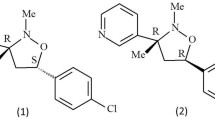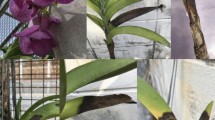Abstract
A combined TBZ — iprodione treatment was more effective in inhibiting growthin vitro ofBotrytis cinerea isolates obtained from decayed celery than either of the fungicides applied separately. This was exhibited for both TBZ-resistant and TBZ-sensitive isolates. TBZ at 500 (μg ml-1 plus iprodione at 1000 μg ml-1 reduced celery decay beyond the reduction obtained by each fungicide alone. When applied prior to inoculation, the combined treatment prevented decay by the TBZ-sensitive/iprodione-resistant isolates and reduced initial decay by the TBZ-resistant/iprodione-sensitive isolates to 3–10% of the level without treatment. Under natural infection conditions iprodione showed better decay control than TBZ, and at 1500 μg ml-1 it reduced initial decay during prolonged storage to 3% of the no-treatment level. Although TBZ (500 μg ml-1) or iprodione (1000 μg ml-1) applied separately reduced decay significantly, the combination of lower concentrations of each fungicide was sufficient to eliminate decay development almost totally. The combined treatment also inhibited decay bySclerotinia sclerotiorum, which contributed 3% of the total soft rot in stored celery.
Similar content being viewed by others
References
Barkai-Golan, R. and Aharoni, N. (1972) Postharvest thiabendazole treatment to prevent spoilage in stored celery.Isr. J. Agric. Res. 22:157–159.
Barkai-Golan, R. and Aharoni, N. (1980) GA3 for the control of soft rot in stored celery. Proc.5th Congr. Mediterranean Phytopathological Union (Patras, Greece), pp. 167–169.
Barkai-Golan, R., Aharoni, N. and Ben-Yehoshua, S. (1971) Control of stored celery rots by two systemic fungicides. Proc.2nd Int. Congr. Pesticide Chemistry (Tel Aviv, Israel), Vol. 1, pp. 405–411.
Barkai-Golan, R., Aharoni, N., Karadavid, R. and Dvir, O. (1987) Alternative postharvest treatments to thiabendazole to control decay in stored celery,in: Scientific Activities 1983–1986, Inst, of Technology and Storage of Agricultural Products, ARO, Bet Dagan, Israel. Spec. Publ. No. 239, p. 120.
Bollen, G.J. and Scholten, G. (1971) Acquired resistance to benomyl and some other systemic fungicides in a strain ofBotrytis cinerea in cyclamen.Neth. J. Plant Pathol. 77:83–90.
Clemons, G.P. and Sisler, H.D. (1971) Localization of the site of action of a fungitoxic benomyl derivate.Pestic. Biochem. Physiol. 1:32–42.
Davidse, L.C. (1973) Antimitotic activity of methyl benzimidazol-2-yl carbamate (MCB) inAspergillus nidulans.Pestic. Biochem. Physiol. 3:317–325.
Davidse, L.C. (1988) Benzimidazole fungicides: Mechanism of action and resistance.in: Delp, C.J. [Ed.] Fungicide Resistance in North America. APS Press, St. Paul, MN, USA. pp. 25–27.
Dekker, J. (1976) Acquired resistance to fungicides.Annu. Rev. Phytopathol. 14:405–428.
Delp, C.J. (1980) Coping with resistance to plant disease control agents.Plant Dis. 64:652–658.
Delp, C.J. (1987) Benzimidazole and related fungicides.in: Lyr, H. [Ed.] Modern Selective Fungicides. VEB Gustav Fischer Verlag, Jena, and Longman Group UK Ltd., London. pp. 233–244.
Eckert, J.W. (1988) Dynamics of benzimidazole-resistant penicillia in the development of postharvest decays of citrus and pome fruits,in: Delp, C.J. [Ed.] Fungicide Resistance in North America. APS Press, St. Paul, MN, USA. pp. 31–36.
Eckert, J.W. and Ogawa, J.M. (1988) The chemical control of postharvest diseases: deciduous fruits, berries, vegetables and root/tuber crops.Annu. Rev. Phytopathol. 26:433–469.
Edlich, W. and Lyr, H. (1987) Mechanism of action of dicarboximide fungicides.in: Lyr, H. [Ed.] Modem Selective Fungicides. VEB Gustav Fischer Verlag, Jena, and Longman Group UK Ltd., London. pp. 107–118.
Elad, Y. (1992) Reduced sensitivity ofBotrytis cinerea to two sterol biosynthesis-inhibiting fungicides: fenetrazole and fenethanil.Plant Pathol. 41:47–54.
Fritz, R., Leroux, P. and Gredt, M. (1977) Mecanisme de l’action fongitoxique de la procimidione (26019 RP ou glycophene) de la vinclozoline et du dicloran surBotrytis cinerea Pers.Phytopathol. Z. 90:152–163.
Georgopoulos, S.G., Sarris, M. and Ziogas, B.N. (1979) Mitotic instability inAspergillus nidulans caused by the fungicides iprodione, procymidone and vinclozolin.Pestic. Sci. 10:389–392.
Hammerschlag, R.S. and Sisler, H.D. (1973) Benomyl and methyl-2-benzimidazole carbamate (MCB): Biochemical, cytological and chemical aspects of toxicity toUstilago maydis andSaccharomyces cerevisiae.Pestic. Biochem. Physiol. 3:42–54.
Katan, T. (1982) Resistance to 3,5-dichlorophenyl-N-cyclic imide (‘dicarboximide’) fungicides in the gray mould pathogenBotrytis cinerea on protected crops.Plant Pathol. 31:133–141.
Katan, T. (1985) Failure to detect highly resistant strains in dicarboximide resistant field population ofBotrytis cinerea.Bull. OEPP 15:371–377.
Kato, T. (1983) Mode of antifungal action of a new fungicide tolclofosmethyl.in: Miyamoto, J. and Kearney, P.C. [Eds.] Pesticide Chemistry: Human Welfare and the Environment. Pergamon Press, New York, NY. Vol. 3, pp. 153–157.
Leroux, P., Fritz, R. and Gredt, M. (1983) Cross resistance between 3,5-dichlorophenyl cyclic imide fungicides (Dichlozolin, Iprodione, Procymidone, Vinclozolin) and various aromatic compounds.in: Lyr, H. and Polter, C. [Eds.] Systemische Fungizide und Antifungale Verbindungen. Abh. Akad. d. Wiss. DDR, Akademie-Verlage, Berlin, Germany. pp. 79–88.
Lorenz, G. (1988) Dicarboximide fungicides: history of resistance development and monitoring methods.in: Delp, C.J. [Ed.] Fungicide Resistance in North America. APS Press, St. Paul., MN, USA. pp. 45–51.
Morris, N.R. (1986) The molecular genetics of microtubule proteins in fungi.Exp. Mycol. 19:77–82.
Sheir-Neiss, G., Lai, M.H. and Morris, N.R. (1978) Identification of a gene for β-tubulin inAspergillus nidulans.Cell 15:639–649.
Smith, C.M. (1988) History of benzimidazole use and resistance.in: Delp, C.J. [Ed.] Fungicide Resistance in North America. APS Press, St. Paul., MN, USA. pp. 23–24.
Author information
Authors and Affiliations
Rights and permissions
About this article
Cite this article
Barkai-Golan, R., Afek, U. & Aharoni, N. The advantage of tbz + iprodione treatment for control of gray mold decay of celery caused by the heterogenic spore population ofBotrytis cinerea in Israel. Phytoparasitica 21, 293–301 (1993). https://doi.org/10.1007/BF02981047
Received:
Issue Date:
DOI: https://doi.org/10.1007/BF02981047




